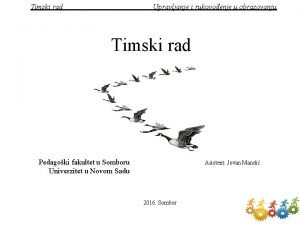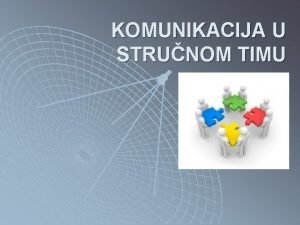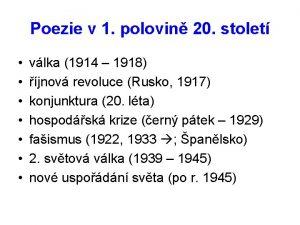Moja uloga u politikom timu Novi lideri nove
























- Slides: 24

Moja uloga u političkom timu Novi lideri – nove mogućnosti 25. juli 2018. Milorad Bjeletić



Belbin's Team Roles Action Oriented Roles People Oriented Roles Thought Oriented Roles Shaper Challenges the team to improve. Implementer Puts ideas into action. Completer-Finisher Ensures thorough, timely completion. Coordinator Acts as a chairperson. Team Worker Encourages cooperation. Resource Investigator Explores outside opportunities. Plant Presents new ideas and approaches. Monitor-Evaluator Analyzes the options.


Team Roles Summary Description

Balanced teams? When there is a balance of primary roles and when team members know their roles, work to their strengths and actively manage weaknesses. To achieve the best balance, there should be − one Co-ordinator or Shaper (not both) for leader − a Plant to stimulate ideas − a Monitor/evaluator to maintain honesty and clarity − one or more Implementer, Team worker, Resource investigator or Completer/finisher to make things happen.

How to use it 1/2 Use Belbin's model to analyze your team, and as a guide as you develop your team's strengths, and manage its weaknesses: 1. 2. 3. 4. Over a period of time, observe the individual members of your team, and see how they behave, contribute and behave within the team. Now list the members of the team, and for each person write down the key strengths and characteristics you have observed. (You may also want to note down any observed weaknesses). Compare each person's listed strengths and weakness with the Belbin's descriptions of team roles, and note the role that most accurately describes that person. Once you have done this for each team member, consider the following questions: – Which team roles are missing from your team? And from this, ask yourself which strengths are likely to be missing from the team overall? – Is there a prevalent team role that many of the team members share?

…using Belbin 2/2 • In addition, analysing existing teams and their performance or behaviour, using these team role concepts, can lead to improvements, for example: – – Under-achievement demands a good coordinator or finisher Conflict requires a team worker or strong coordinator Mediocre performance needs a resource investigator, innovator or shaper Error prone teams need an evaluator. • Different roles are important in different circumstances, for example: – New teams need a strong shaper to get started. – Competitive situations demand an innovator with good ideas. – In areas of high risk, a good evaluator may be needed. • Teams should, be analysed both in terms of what team roles members can play, and also in relation to what team skills are most needed.

Margerison-Mc. Cann Team Performance Wheel

Diversity of Members (Robbins and Judge)




Leadership and Management Leadership is doing the right things; management is doing things right. - Peter Drucker

What Do They Mean? Leadership The ability of an individual to influence, motivate, and enable others to contribute toward the effectiveness and success of the organizations of which they are members. Management Directing and controlling a group of one or more people or entities for the purpose of coordinating and harmonizing that group towards accomplishing a goal.

Leader and manager: lexical definition? Leader Manager • A person who leads, • A person responsible commands a group of for controlling or people, especially a administrating of an head of an organisation or group (party, country, etc) of staff. • A person who inspires, • A person who controls guides, rules others the professional and business activities of a performer

Leader vs. Manager Characteristic Differences Manager • Attention to detail • Motivated by reward & punishment • Low on interpersonal skill • Reactive than proactive • Strives on efficiency • Sticks to rules, policies & regulations. Leader Innovator Motivator Role model Interpersonal skills Values staff Promoter of positive punishment • Proactive • • •

Leader vs. Manager – Nine Truths 1. The manager administers; the leader innovates 2. The manager maintains; the leader develops 3. The manager accepts reality; the leader investigates 4. The manager focuses on systems and structure; the leader focuses on people 5. The manager relies on control; the leader inspires trust

vs M Leader vs. LManager (continued) 6. The manager has a short-range view; the leader has a long range perspective 7. The manager asks how and when; the leader asks why and why not? 8. The manager has his or her eye always on the bottom line; the leader has his or her eye on the horizon 9. The manager accepts the status quo; the leader challenges it.

But, the most important? • Which do you want to be? Why?

Guidelines for Leaders Articulate a clear and appealing vision. Explain how the vision can be attained. Act confident and optimistic. Express confidence in followers. Use dramatic, symbolic actions to emphasize key values. • Lead by example. • • • (Yukl, 2010)

Leadership Styles • Autocratic or Authoritarian Style of Leadership • Democratic Style of Leadership • Laissez-faire Style of Leadership • Transactional Style of Leadership • Transformational Style Of Leadership There are many more!!!!

 Evropa posle versaja
Evropa posle versaja Dotkni sa mojich očí pane
Dotkni sa mojich očí pane Uloge u timu
Uloge u timu Arti i bindjes
Arti i bindjes Komunikacija u timu
Komunikacija u timu Aiklar
Aiklar Merkezi vatikan olan mezhep
Merkezi vatikan olan mezhep Regola del nove
Regola del nove Regola del nove
Regola del nove Franská ríša
Franská ríša Regola del nove
Regola del nove Nové dopravné značky na slovensku
Nové dopravné značky na slovensku Metrorragia
Metrorragia Svetové hospodárstvo a nové usporiadanie štátov
Svetové hospodárstvo a nové usporiadanie štátov Nove
Nove Stato soporoso e stuporoso
Stato soporoso e stuporoso Podemos dividir o reino animal em nove filos
Podemos dividir o reino animal em nove filos Morgenstern trychtýře
Morgenstern trychtýře Regola del nove
Regola del nove Struttura purgatorio
Struttura purgatorio Uvedba nove spremenljivke integral
Uvedba nove spremenljivke integral Formy marketingovej komunikácie
Formy marketingovej komunikácie Um poliedro convexo tem 12 vertices e 18 arestas
Um poliedro convexo tem 12 vertices e 18 arestas Canto xiii parafrasi
Canto xiii parafrasi škola u prirodi novi vinodolski
škola u prirodi novi vinodolski















































